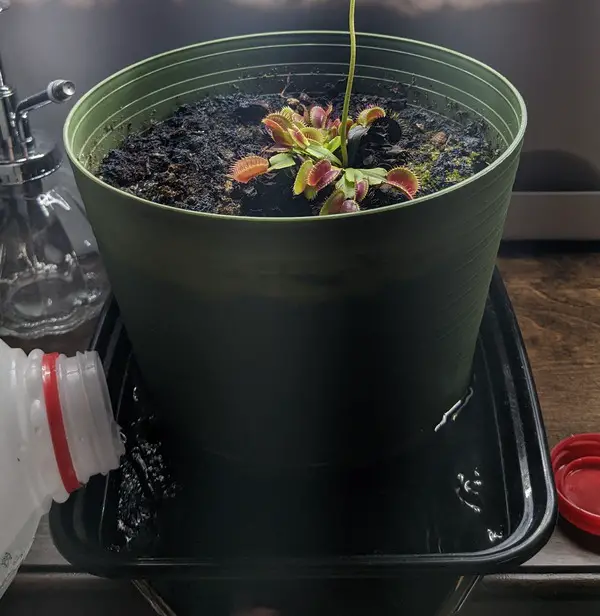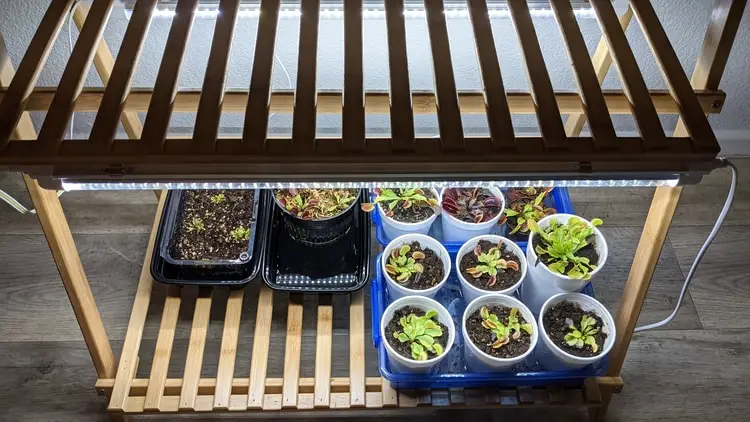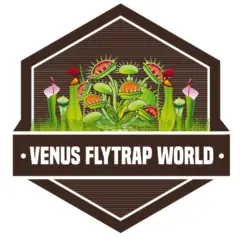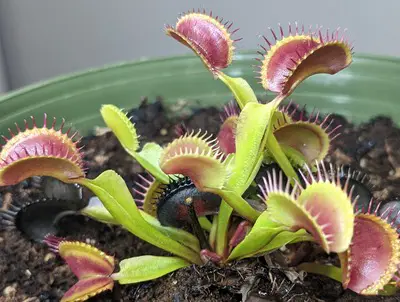Growing Venus fly traps and carnivorous plants is very rewarding. When I first got started I was concerned it would be too hard. To my pleasant surprise, I discovered that growing Venus fly traps is attainable to almost anyone, regarding of your climate.
Venus flytraps require significant amounts of pure water (distilled or rainwater), carnivorous plant soil, and lots of sunlight to thrive. They don’t need to be fed and they are best grown outdoors under direct sunlight.
After growing Venus fly traps and carnivorous plants for over 5 years, I would say that Venus fly traps are an intermediate difficulty plant. It does have some very specific requirements, but it is also very resilient. It is difficult to overwater and it can adapt to varied climates. And, healthy Venus fly traps can live for about 20 years without issues! 🙂
Now, if you really want to grow Venus fly traps at home, you can follow these instructions to ensure success. Best of luck!
Venus Fly Trap Care at Home 101 Summary
– Water your plant only with Distilled, reverse osmosis or rain water and keep the soil humid at all times.
– Employ carnivorous plant soil for Venus fly traps, never use standard potting soil.
– Provide plenty of sunlight, at least 4 -6 hours of direct sunlight 9more is recommended 😉 )
– Feed a single insect every 2 to 6 years if growing them indoors. Outdoor Venus fly trap do not require feeding.
– Do not feed human food to your Venus Fly trap
If you are currently struggling with a plant, this article can help you: How to Save Your Venus Fly Trap.
Watering:

First, watering Venus fly traps can be a bit tricky. You can’t use standard tapster or bottled water. You will need pure, mineral-free water.
Use distilled water, reverse osmosis water or rainwater to water Venus flytraps. Most standard tap-water or bottled water will kill Venus flytraps, make sure to avoid at all costs.
This article can give you the complete list of safe and unsafe water types.
Second, Venus fly traps thrive is high humidity. You will need to water your plant often to keep them alive.
Water Venus fly traps every 2 to 5 days ensuring the soil is always humid, but never flooded. The soil should never go completely dry as this can harm and kill Venus fly traps.
For best results, water Venus fly traps from the bottom by placing them in a tray with 1-3 inches of water and let the plant consume the water. Once the water is gone from the tray, refill it right away.
The tray method is effective when growing them indoors or outdoors. Also, it helps increase the overall humidity.
Soil
Venus fly traps are very sensitive to minerals, for that reason they can’t be grown in standard potting soil like Miracle grow.
Cactus soil, succulent soil, and the vast majority of soil is unsuitable for Venus fly traps. the nutrients will burn the leaves and end up killing the plant.
Venus fly trap require nutrient-free soil that can retain moisture and promote drainage. Carnivorous plant potting mixes are available to meet this requirements and are made up of a combination of moss and perlite or sand.
You can buy carnivorous plant soil or make it yourself. This is an example of an affordable and effective carnivorous plant soil mix. It usually costs less than 10 dollars for a quart. Follow the link to confirm the price on Amazon.com.
When selecting the soil, make you find the correct type. Here is a guide that lists the best soil options.
Lighting
Venus fly traps thrive in bright lighting. they actually require tons of light to survive.
Grow Venus fly traps in a bright location with at least 4 to 6 hours of direct lights. Optimally they should receive 10 or 12 hours of bright direct sunlight. Indirect sunlight is also beneficial as a supplement, but in most cases not enough as a single source of light.
Sunlight works best for Venus fly traps due to its intensity. However, Venus fly traps can also grow indoors at home.
Indoors, Venus fly traps will still require plenty of lighting. Some plants grow well in bright windowsills or under artificial lights,
Venus flytraps can remain healthy if exposed to more than 6 hours of artificial lighting. For optimal results, provide over 10 hours of artificial lights with LEDs or fluorescent bulbs of at least 1500 lumens.
Artificial light can also be used as an addition if sunlight is not enough.
Healthy Venus fly traps will exhibit large traps with bright colors and will often divide and propagate. Without proper lighting, Venus fly traps sometimes lose their colors and the traps tend to shrink or deformed. To grow healthy leaves back you can follow these instructions.
Here is a complete guide on lighting. Mastering is key to keep your plant healthy 🙂

Feeding
In the wild, Venus fly traps capture insects to extract nutrients and boost their diet. However, they don’t need to catch bugs to survive.
Growing Venus flytraps outdoors ensure they will have access to insects. However, indoor Venus fly traps will sometimes struggle.
Feed indoor Venus fly traps once every 2 to 6 weeks to boost their growth. A single insects for the whole path is enough to provide key nutrients.
Avoid feeding any type of human food to Venus fly traps. They won’t be able to consume it.
Most insects or spiders are suitable for Venus fly traps. Select a bug that can fit completely inside the leaf of your plant. As a rule of thumb, prey that is maximum 1/3 of the size of the leaf are suitable.
Flies, ants, spiders, mealworms, small crickets, bloodworms and other insects are very nutritious for Venus fly traps.
This article has a complete list of what you should and shouldn’t feed a Venus fly trap.
Never feed human food to Venus fly traps (these options are much better). The plant won’t be able to digest it and it might attract mold.
This article can help you learn how to feed Venus fly traps and avoid black leaves plus there is a helpful video for a visual guide.
Climate: Temperature + Humidity
Venus fly traps can adapt to a variety of climates. In their natural habitat they live in high humidity and go through all four seasons with very sunny summers.
Venus fly traps can grow at room temperature in your house through the growing season. However, they do require a dormancy period. A few months of close to freezing temperatures and shorter days to go dormant and get ready for blooming in the spring.
The optimal temperature range for Venus flytraps during the summer months is 70-95 F. Above 95 to 100 F; Venus flytraps are at risk of drying up and dying.
During the winter, Venus flytraps also require a particular temperature to stay healthy.
20-45 F is the optimal temperature range for Venus flytraps during the winter. Venus flytraps require cold weather to achieve dormancy, essential for their survival. To complete a full dormancy, temperatures must remain below 50 F for at least three months.
In terms of humidity, Venus fly traps prefer high humidity environments (over 50%), however they can grow in almost any humidity. I grow mine in an arid climate and my plants have adapted 🙂
Venus fly traps do not need terrariums or misting. Instead, water your plant to keep the soil humid at all times.
Additional Care Considerations
Flowering:
When a Venus fly trap is mature, they produce flowers. The flowering process can drain energy from the plant (which can kill it) and slow down growth. You can learn more about the flowering process and what to do with this article.
Suitable pots:
Do not place Venus flytraps in enclosed containers. Venus flytraps prefer standard open plant pots with drainage holes.
Use plastic or glazed ceramic posts for Venus flytraps. Depending on the plant’s size, choose a container of about 2-6 inches in diameter. Tall containers of over 4 inches in depth work best as the roots of Venus flytraps grow to be very lengthy.
Avoid terra cotta or unglazed ceramic pots as those leach harmful minerals for Venus flytrap.
Repotting:
Repot the plant once a year to avoid soil compression, fungus, and mold. Empty the old soil and replace with fresh soil. For best results repot at the end of the dormancy period.
Trimming:
When leaves in a Venus flytrap dry up, they turn black. Remove them once they dry out completely.
A couple of dry leaves are not a sign of poor growing conditions. Dead leaves are completely normal. Only worry if you notice a sudden increase in black leaves or if you plant is running our of healthy growth.
Fertilizers:
Do not fertilize Venus flytraps. The chemicals and overall nutrients in the fertilizers can hurt the plant.
Stress:
Do not play with the traps of your plant; it causes stress. Triggering the traps to close without food is discouraged.
Size:
You can encourage fast growth in your plant by feeding it, using tall pots, and following these tips on how to grow big venus fly traps.
Dormancy:
Venus flytraps must undergo a dormancy period of 2-3 months during the winter. Ensure your plant will experience this yearly resting period by placing them in a cold location.
Achieving dormancy inside your home will be challenging unless you have an unheated garage or porch. To ensure your plant goes dormant, you will in most cases need to place your plant outside in the cold.


